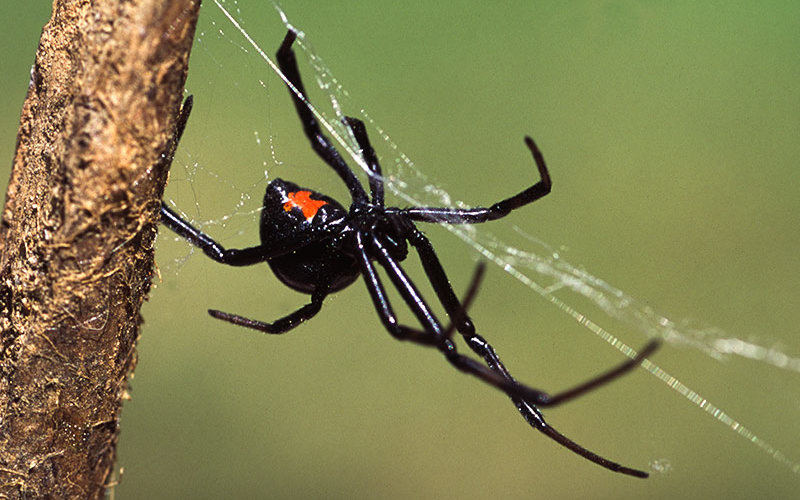
Cal State Fullerton spider researcher Merri Lynn Casem and her students are untangling a web of mystery surrounding the 1900 death of a construction worker bitten by a black widow spider. Did the man die from the venom of this highly poisonous spider or a fatal mistake by the doctor treating him?
The researchers are investigating the historic case of the man’s death on July 26, 1900, from a modern-day perspective of understanding the biological effects of black widow venom and the treatments he received.
The man was bitten by the spider while using an outhouse at the construction site of the first Masonic Temple, now the Parker Building, in downtown Fullerton. He was treated by Dr. George Crook Clark, one of Fullerton’s pioneer doctors and the original owner of what is now the Heritage House at the Fullerton Arboretum, located on the CSUF campus.
The researchers are working on a manuscript to describe how the physiological effects of the spider venom and the various drugs used to treat the patient may have combined to result in one of the first medically documented cases in the nation of a fatal black widow spider bite. Their work is based on an article describing the case published in the Southern California Practitioner in 1901.
“At the time, the venomous nature of the black widow was not recognized,” said Casem, chair and professor of biological science who studies the cellular and molecular biology of spider silk, as well as spider development. “Because of this, Dr. Clark would not have known the best way to treat a black widow spider bite.”
Casem’s students, biological science majors Omniya Abdelmaksoud and Sharon Chang, are studying the medicines used in the early 1900s and the physiological effects the black widow spider toxin, called alpha latrotoxin, has on the human body. The spider, whose scientific name is Latrodectus hesperus, is known for the prominent red hourglass pattern on its belly.
Chang, a double major also studying anthropology, plans to become a physician. She became interested in the research because of its relevance to the history of medicine.
“In our case study we emphasize the overlap between history and science,” said Chang, who received a research stipend from Friends of the Arboretum for the study. “Our understanding about the effects of alpha latrotoxin has changed over the past 100 years with the advancements in medicine and biology. Piecing together the knowledge we have now, with what happened back then, is an important focus of our research.”
A Deadly Spider Bite?
The physician’s treatment focused on preventing infection and relieving the patient’s extreme pain by using drugs that included potassium permanganate (an antifungal and antiseptic agent), an 8% solution of cocaine as an analgesic and morphine, Casem explained.
It was reported that the patient, whose name was George, was convinced he was going to die when his condition did not improve with treatment. He took matters into his own hands by downing several six-ounce glasses of whiskey, Casem said. When his breathing became labored and he lost consciousness, Dr. Clark attempted to revive him using ammonia and camphor inhalation.
“When that did not work, Dr. Clark injected George with strychnine and whiskey,” Casem said.
Strychnine, a lethal poison, was used as a therapeutic agent at the turn of the century. The patient died 14 hours after being bitten. The cause of death was reported as blood poisoning. After George’s death, the black widow spider was discovered in the outhouse.
While dying from a black widow bite is rare, black widow spiders remain a potential health threat due to the alpha latrotoxin protein found in their venom, Casem said. Symptoms include body pain, severe muscle cramping, nausea and abnormal heart rate. Modern treatments focus on pain relief, including the use of opioids. An antivenom can be used in severe cases.
“Alpha latrotoxin protein functions to disrupt the nervous system by forming calcium ion channels in the membranes of nerve cells. Calcium ion plays a critical role in the communication between nerve cells, so disrupting the levels of calcium in the nerve would result in ‘misfiring’ and lead to muscle contractions and pain,” Casem said.
The most recent data reveals that of the 1,015 cases of black widow spider bites recorded in 2018, there were no deaths and six patients suffered potentially life-threatening symptoms.
Casem and her students’ research concludes that while Dr. Clark followed accepted medical practice of the time for blood poisoning, some of the drugs used, such as strychnine, combined with the patient’s consumption of alcohol, could have contributed to the fatal outcome.
“Was the spider responsible, the doctor, or George himself? This research is the sort of story that can be left for the reader to decide,” Casem said.
Contact: Debra Cano Ramos, dcanoramos@fullerton.edu